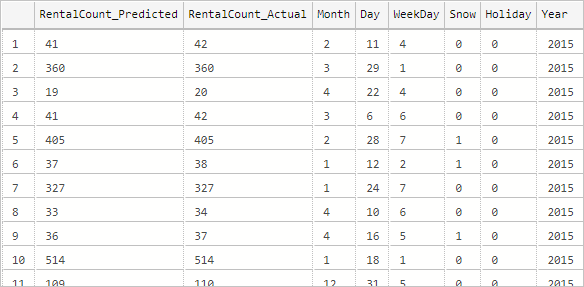適用対象:AZURE SQL
Managed Instance SQL Server 2017 (14.x) 以降のバージョン
この 4 部構成のチュートリアル シリーズのパート 4 では、Machine Learning Services またはビッグ データ クラスターを使用して、Python で開発された線形回帰モデルを SQL Server データベースにデプロイします。
この 4 部構成のチュートリアル シリーズのパート 4 では、Machine Learning Services を使用して、Python で開発された線形回帰モデルを SQL Server データベースにデプロイします。
この 4 部構成のチュートリアル シリーズのパート 4 では、Machine Learning Services を使用して、Python で開発された線形回帰モデルを Azure SQL Managed Instance データベースにデプロイします。
この記事では、次の方法について学習します。
- 機械学習モデルを生成するストアド プロシージャを作成する
- データベース テーブルにモデルを格納する
- モデルを使用して予測を行うストアド プロシージャを作成する
- 新しいデータでモデルを実行する
第 1 部では、サンプル データベースを復元する方法を学習しました。
パート 2 では、データベースから Python データ フレームにデータを読み込み、Python でデータを準備する方法を学習しました。
パート 3 では、Python で線形回帰機械学習モデルをトレーニングする方法について学習しました。
前提条件
- このチュートリアルのパート 4 は、パート 1 とその前提条件を完了していることを前提としています。
モデルを生成するストアド プロシージャの作成
では、開発した Python スクリプトを使用して、scikit-learn の LinearRegression を使用して線形回帰モデルをトレーニングする generate_rental_py_model というストアド プロシージャを作成してみましょう。
Azure Data Studio で次の T-SQL ステートメントを実行し、モデルをトレーニングするストアド プロシージャを作成します。
-- Stored procedure that trains and generates a Python model using the rental_data and a linear regression algorithm
DROP PROCEDURE IF EXISTS generate_rental_py_model;
go
CREATE PROCEDURE generate_rental_py_model (@trained_model varbinary(max) OUTPUT)
AS
BEGIN
EXECUTE sp_execute_external_script
@language = N'Python'
, @script = N'
from sklearn.linear_model import LinearRegression
import pickle
df = rental_train_data
# Get all the columns from the dataframe.
columns = df.columns.tolist()
# Store the variable well be predicting on.
target = "RentalCount"
# Initialize the model class.
lin_model = LinearRegression()
# Fit the model to the training data.
lin_model.fit(df[columns], df[target])
# Before saving the model to the DB table, convert it to a binary object
trained_model = pickle.dumps(lin_model)'
, @input_data_1 = N'select "RentalCount", "Year", "Month", "Day", "WeekDay", "Snow", "Holiday" from dbo.rental_data where Year < 2015'
, @input_data_1_name = N'rental_train_data'
, @params = N'@trained_model varbinary(max) OUTPUT'
, @trained_model = @trained_model OUTPUT;
END;
GO
データベース テーブルにモデルを格納する
TutorialDB データベースにテーブルを作成し、そのテーブルにモデルを保存します。
Azure Data Studio で次の T-SQL ステートメントを実行し、モデルの格納に使用される dbo. rental_py_models という名前のテーブルを作成します。
USE TutorialDB; DROP TABLE IF EXISTS dbo.rental_py_models; GO CREATE TABLE dbo.rental_py_models ( model_name VARCHAR(30) NOT NULL DEFAULT('default model') PRIMARY KEY, model VARBINARY(MAX) NOT NULL ); GOlinear_model というモデル名を使用して、モデルをバイナリ オブジェクトとしてテーブルに保存します。
DECLARE @model VARBINARY(MAX); EXECUTE generate_rental_py_model @model OUTPUT; INSERT INTO rental_py_models (model_name, model) VALUES('linear_model', @model);
予測を行うストアド プロシージャを作成する
トレーニング済みのモデルと一連の新しいデータを使用して予測を行う、py_predict_rentalcount というストアド プロシージャを作成します。 次の T-SQL を Azure Data Studio で実行します。
DROP PROCEDURE IF EXISTS py_predict_rentalcount; GO CREATE PROCEDURE py_predict_rentalcount (@model varchar(100)) AS BEGIN DECLARE @py_model varbinary(max) = (select model from rental_py_models where model_name = @model); EXECUTE sp_execute_external_script @language = N'Python', @script = N' # Import the scikit-learn function to compute error. from sklearn.metrics import mean_squared_error import pickle import pandas rental_model = pickle.loads(py_model) df = rental_score_data # Get all the columns from the dataframe. columns = df.columns.tolist() # Variable you will be predicting on. target = "RentalCount" # Generate the predictions for the test set. lin_predictions = rental_model.predict(df[columns]) print(lin_predictions) # Compute error between the test predictions and the actual values. lin_mse = mean_squared_error(lin_predictions, df[target]) #print(lin_mse) predictions_df = pandas.DataFrame(lin_predictions) OutputDataSet = pandas.concat([predictions_df, df["RentalCount"], df["Month"], df["Day"], df["WeekDay"], df["Snow"], df["Holiday"], df["Year"]], axis=1) ' , @input_data_1 = N'Select "RentalCount", "Year" ,"Month", "Day", "WeekDay", "Snow", "Holiday" from rental_data where Year = 2015' , @input_data_1_name = N'rental_score_data' , @params = N'@py_model varbinary(max)' , @py_model = @py_model with result sets (("RentalCount_Predicted" float, "RentalCount" float, "Month" float,"Day" float,"WeekDay" float,"Snow" float,"Holiday" float, "Year" float)); END; GO予測を格納するテーブルを作成します。
DROP TABLE IF EXISTS [dbo].[py_rental_predictions]; GO CREATE TABLE [dbo].[py_rental_predictions]( [RentalCount_Predicted] [int] NULL, [RentalCount_Actual] [int] NULL, [Month] [int] NULL, [Day] [int] NULL, [WeekDay] [int] NULL, [Snow] [int] NULL, [Holiday] [int] NULL, [Year] [int] NULL ) ON [PRIMARY] GOストアド プロシージャを実行してレンタル カウントを予測する
--Insert the results of the predictions for test set into a table INSERT INTO py_rental_predictions EXEC py_predict_rentalcount 'linear_model'; -- Select contents of the table SELECT * FROM py_rental_predictions;次のような結果が表示されます。

モデルを正常に作成し、トレーニングしてデプロイしました。 そうしたら、ストアド プロシージャでそのモデルを使用して、新しいデータに基づいて値を予測します。
次のステップ
本チュートリアル シリーズのパート 4 では、以下の手順を完了しました。
- 機械学習モデルを生成するストアド プロシージャを作成する
- データベース テーブルにモデルを格納する
- モデルを使用して予測を行うストアド プロシージャを作成する
- 新しいデータでモデルを実行する
SQL 機械学習における Python の使用について詳しくは、以下を参照してください。